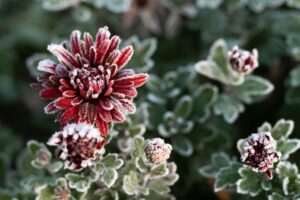
In the spring and summer months, care for plants revolves around feeding and watering them. The protection you provide from the heat comes from making sure they’re always hydrated. However, in winter, a hard freeze can damage and even kill your plants.
At Siara Designs, our Dallas landscape design and installation can share steps you to take that may save your plants. Much of it is a waiting game. Listed below are some steps you can take to care for your plants that have been damaged by frost.
Why Frost Harms Plants
Plants are full of fluid. When the temperatures dip, the fluid inside the plants freezes, and as with most frozen liquids, ice crystals form. These ice crystals damage the cell walls and cause them to rupture. These ruptures cause the fluids in the cells to drain from the plant.
Frost or Freeze
There are some key things that you should know if you are caring for plants during the winter months. One of the most important things to know is the distinction between a frost and a freeze. You can see frost-It is that visible white layer of ice that you often see on the lawn in the early morning.
When the temperature drops below freezing and there is humidity, you will often see a frost build up on the ground and plants. You do not have to see frost for plants to be damaged by freezing temperatures. In these cases, often the humidity is low, and the temperatures are doing the damage internally to the plant.
Plants Susceptible to Frost
Plants respond differently to frost. Some, especially those meant for warm temperatures, are very vulnerable to the damage that can be done by frost. Tropical plants are intended to grow in warm temperatures. Though, with the right care, it can grow well outside of those zones. However, tropical plants must be protected from cold temperatures.
Hardier plants that are in excellent health and are more mature can tolerate cold temperatures better. Younger plants with tender stems and foliage will not withstand frost nearly as safely. It is crucial not to transplant any tender, new-growth plants to an outdoor garden before the threat of frost is behind you.
Avoid Further Damage
Frost damage is not always immediately recognized. So, practicing a wait-and-see approach is usually the route you must take. Sometimes, taking what could feel like appropriate action is the worst thing you could do for your plant.
Pruning Is a Bad Idea
Do not immediately begin cutting off the parts you believe are damaged. This can actually cause more harm to the already frost-damaged plant. When you prune a plant, the area of the plant that was clipped is essentially injured.
So, the plant automatically has to send its energy and effort to the wounds the pruning inflicted for repair. By not pruning the parts that seem damaged, the plant can instead focus its energy on the recovery process needed to overcome the frost injuries.
Bypass Fertilizing
Another instinct that many of us have is to feed an injured plant. It seems logical that food is energy, so fertilizing a plant that has been damaged would lend it the boost of energy it needs to repair itself. However, this could not be further from what the plant needs. If you fertilize a plant while temperatures are gradually becoming lower, it threatens to harm your plants.
Fertilizing them will persuade them to develop new growth. The tender leaves and stems of new growth are even more susceptible to damage from the cold. Avoiding fertilizer is a way to insulate plants from forming vulnerable growth that will make the plant more sensitive to damage if it becomes cold outside again.
Watering Can Be Helpful
The most helpful thing you can do for a frost-damaged plant is to see that it has plenty of water. The caveat is you must take special care not to overwater. Too much water can mean that the plants’ roots are sitting in water and can drown their roots because of a deficiency of oxygen.
The leaves can become yellow, and growth can be stunted. By watering properly, the plant will continue to grow at a proper rate. By not overwatering, the plant will get the oxygen it needs to thrive as well.
Bringing Plants Indoors
Some plants are not equipped to spend the colder months outdoors. For these plants, you can prevent frost damage by bringing them indoors before the weather becomes dangerous for them.
If you already notice frost damage on a plant that shouldn’t be outside, bring it inside as soon as possible. Allow the plant a couple of weeks of recuperation time to see if it is permanently damaged.
While it is advisable not to prune away the parts of the plant damaged by frost, there are times when it is okay to remove the damaged parts. Keep an eye on the plant, and if foliage, blooms, or flower buds have died, they will typically begin to shrivel and dry. Once this has happened, you can safely remove them from the plant.
Caring for Plants During the Winter Months
If you choose plants that are suitable to your hardiness zone, you have done yourself a favor and shouldn’t have to do very much for your plants in order for them to make it through the cold months successfully. Perennials, trees, and shrubs suited to the area will not need any heroic measures to get them through the winter. These plants may look bad in the winter months because of the yellowing signals the plant is entering its dormant phase.
Many annuals can spend their winters indoors, and when the temperatures climb and the weather becomes reliably warm again, they can go back outside. However, there are some annuals, such as vegetables like peppers and tomatoes, that are very tender and usually will not be able to be saved by overwintering inside.
Prevention Is Your Best Course of Action
Rather than trying to repair damaged plants, preventing the damage in the first place is the best way to manage your plants. As discussed previously, avoid pruning and fertilizing. Bring them inside if the weather will endanger them.
It is also helpful to grow plants that are within your area’s hardiness zone. Your hardiness zone determines what plants will thrive best in your area. This way, you can avoid a lot of the problems that a frost will bring to plants that are not adapted to cold temperatures.
If you still have plants that you are harvesting, like tomatoes, consider using bubble wrap or other protection on nights when you expect frost or freezing temperatures. This can be removed when temperatures climb and is perfect for protecting plants from temporary cold dips in temperature.
Contact Siara Designs Today
If you have questions about plant care and maintenance or plants that are well suited to your area, Siara Designs can help. To help you achieve an inviting yard that is easy to manage in all four seasons, reach out to our team today. We offer a wide range of lawn and landscaping services.

